Long Live the Chess King
7/22/11Chess sometimes becomes a beautiful game even in the eyes of those who don't play it. Find a charming town, bring back its glorious past, turn people into chess pieces, invite kids and a jester and you can evoke magical moments.
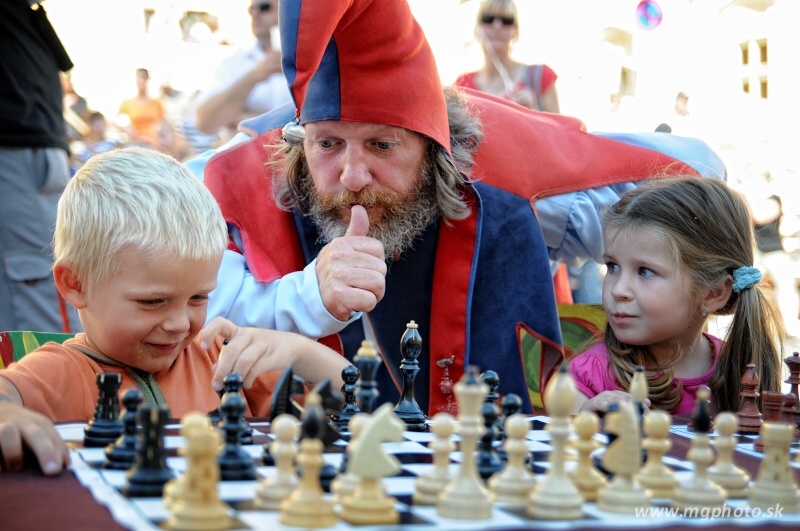
Every year since 2005, the picturesque Slovak town of Banska Stiavnica stages a game of living chess. It is a powerful, almost mystical, spectacle with human chess pieces dressed into medieval costumes and armed with spears and swords. They are moving on a big chessboard to the sound of drums and trumpets.
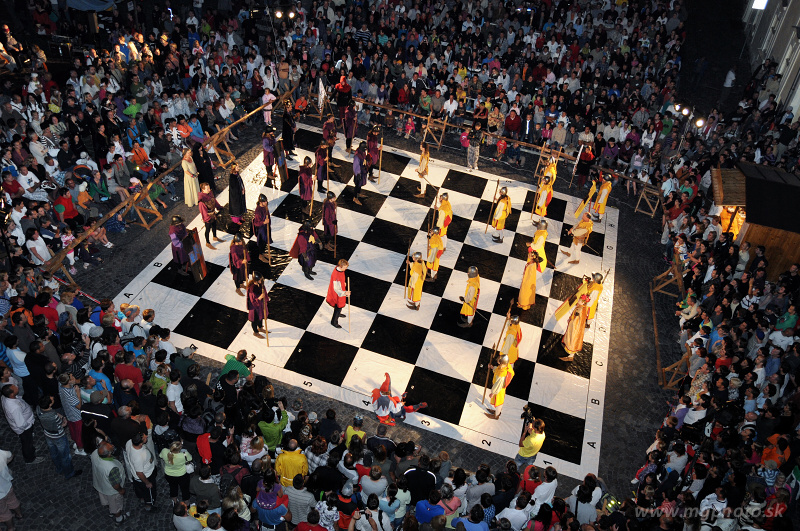
On Saturday, July 16, they were recreating a live blindfold game I was playing against the legendary Hungarian grandmaster Lajos Portisch. The top-rated American grandmaster Hikaru Nakamura became Stiavnica's king last year, defeating GM Sergei Movsesian. Who would get the royal crown this year?

Banska Stiavnica is nestled in the mountains and surrounded by beautiful lakes. Several churches and castles add to the charm of the Slovak town proclaimed by UNESCO as one of its world heritage sites. It was an important place already in the 13th century, rich in gold and silver, with 40,000 inhabitants. Only 10,000 people live there today. Many of them participated in the chess festivities.
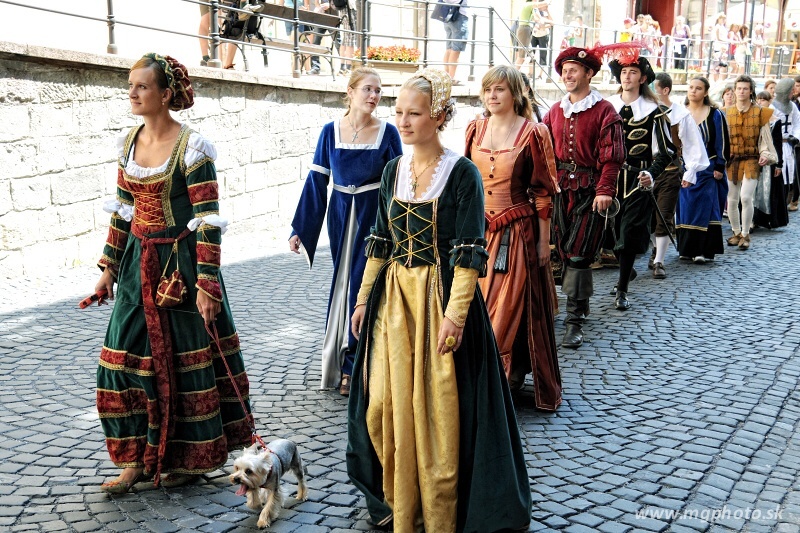
The day of the game began with a costume parade through the town's main street to the Holy Trinity square, where most of the action took place. In the afternoon Portisch and I played simultaneous exhibitions there.
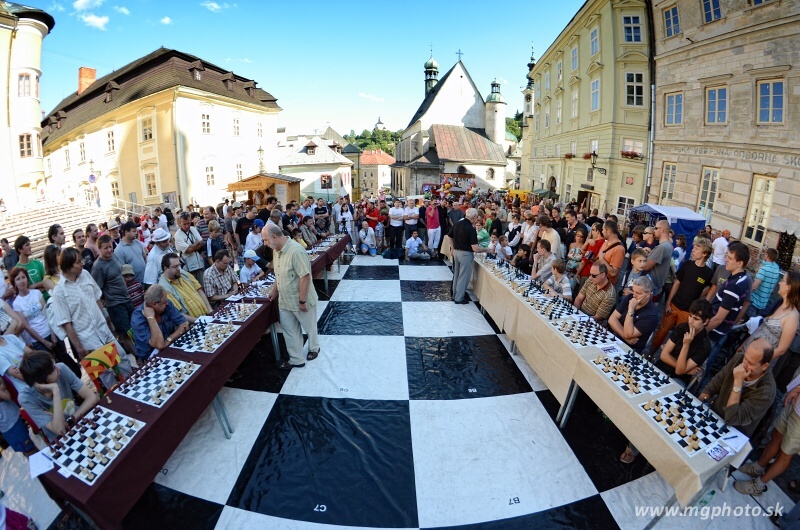
It was in January 1986 when we played a similar exhibition in Italy. Our own encounters over the chessboard go further back. We met the first time at the 1963 Zonal tournament in Halle that Portisch won ahead of Bent Larsen and Bora Ivkov. This grandmaster trio made it even to the Candidates matches. Throughout his career, Portisch was a formidable opponent to anybody and in 1981 was rated as world's number two behind Anatoly Karpov.
During the next five decades Portisch and I fought in two dozen games. He has dominated me in the world-class tournaments, but the advantage tilted slightly in my favor during chess olympiads when we faced each other on the top board. My victory in Thessaloniki in 1984 helped the U.S. team to win the bronze medals just half a point ahead of Hungary. We never played a blindfold game against each other.
Slovakia witnessed a world record in the blindfold simultaneous play in January 1921 in the town of Kosice when another Hungarian champion, Guyla Breyer (1893-1921), played 25 opponents at the same time. Breyer was an immensely talented player and theoretician. His knight leap backward (1.e4 e5 2.Nf3 Nc6 3.Bb5 a6 4.Ba4 Nf6 5.0-0 Be7 6.Re1 b5 7.Bb3 d6 8. c3 0-0 9.h3 Nb8) still gives fits to the proponents of the Spanish game. The defense was used by world-top players from Boris Spassky to Magnus Carlsen.
Portisch came to Banska Stiavnica not only for chess, but to give a singing performance at the closing ceremony of the International Championship of Slovakia -- part of the entire chess festival organized by Milan Maros and his team. Portisch's musical repertoire, mostly Franz Schubert's German romantic songs, fits the chess grandmaster who once famously stated that the main objective in the opening is to reach a playable middlegame.
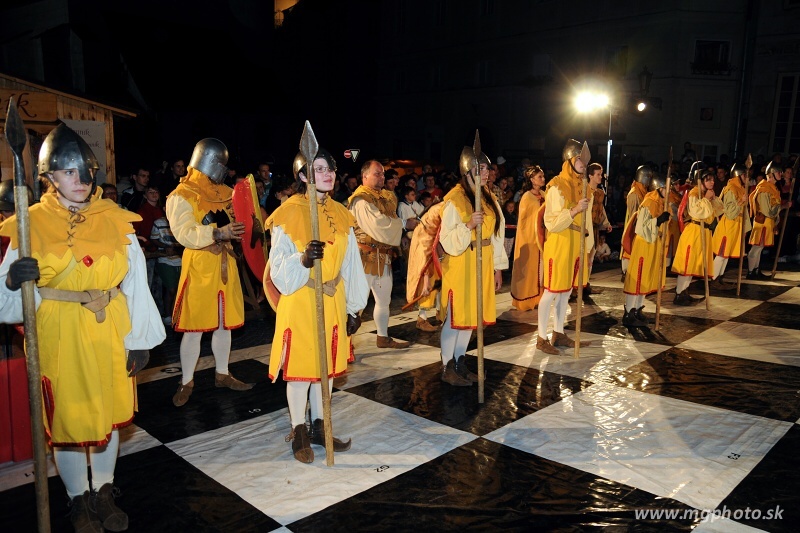
When the darkness fell on Stiavnica's town square, Portisch's pieces were ready. The game could begin.
Portisch - Kavalek
Blindfold-Live chess, Banska Stiavnica,16.07.2011
1.d4 Nf6 2.c4 g6 3.Nc3 Bg7 4.e4 d6 5.f3
(In 1975 in Wijk aan Zee, I won the Leo van Kuijk prize for the most spectacular game of the tournament against Lajos Portisch and the tradition of the spectacular prizes begun. As in this game, the Samisch variation of the King's Indian defense was played and I positionally sacrificed my queen for a mere bishop and a pawn and the game was eventually drawn.)
5...Nc6
(I decided to accelerate Oscar Panno's idea to play on the queenside.)
6.Nge2 0-0 7.Bg5
(For some reason, the bishop move too far has better results than the dominant 7.Be3.)
7...a6 8.Qd2 Rb8 9.h4!?
(Portisch goes for the sharpest line. The positional answer is 9.Rc1.) 9...b5 10.0-0-0 (Larry Christiansen's 10.h5!? is preferable. The white king is pretty safe in the middle.) 10...bxc4 (The stopper 10...h5 makes it more difficult for white to ignite the attack, but in the blindfold game, with the eyes closed, you just go.) 11.h5 Nb4 (I only found out after the game that everything was played before.)
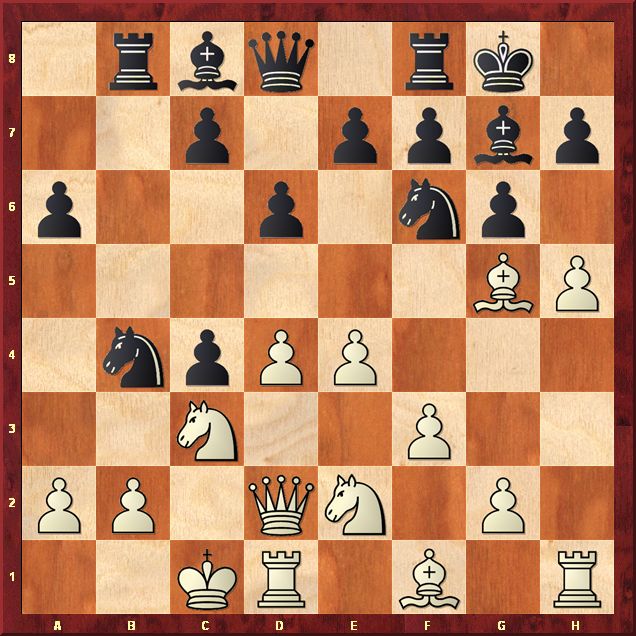
12.Ng3 (Portisch makes a stronger move. In the game Wallach-Naroditsky, Las Vegas 2008, white played 12.Nf4 c5 13.dxc5?! [After 13.hxg6 cxd4 14.Qxd4 hxg6 15.Nxg6 fxg6 16.e5 Be6 17.exf6 exf6 18.Qxd6 Qxd6 19.Rxd6 Kf7 the game is roughly equal.] 13...Qa5 14.hxg6? [14.Bxf6 Bxf6 15.Bxc4 Qxc5 16.Bb3 was necessary.] 14...Nxe4?! [The talented San Francisco junior missed 14...Nxa2+! 15.Nxa2 Qxa2 and black should win.] 15.Nfd5! Rb7 16.gxh7+ [After 16.Nxe4 Nxa2+ 17.Kb1 white wins.] The rest went: 16...Kh8 17.fxe4 Nxa2+ 18.Kc2 Bd7 19.Bxc4 Nxc3 20.Nxc3 Rxb2+ 21.Kxb2 Qa4 22.Bb3 Rb8 23.Qc2 Be6 24.Rd5 Bxd5 25.exd5 dxc5 26.Rh4 c4 27.Kc1 Qa1+ 28.Kd2 cxb3 29.Qd3 Qb2+ 30.Ke3 Qxg2 31.Bf4 Rc8 32.Ne2 b2 33.Qf5 e6 34.dxe6 fxe6 35.Qxe6 Qb7 36.Be5 Rd8 37.Nf4 Qe4+ 38.Kxe4 draw.)
12...c5 (I thought I should bring as many pieces as possible on the queenside to tickle the white king. 12...d5 did not cross my mind since 13.Bh6 gives white a powerful attack; however 12...Nd3+ 13.Bxd3 cxd3 would have slowed white's advances.) 13.d5 (Lajos is playing it safe. He could have gained a clear advantage with 13.hxg6 cxd4 14.Bxf6 exf6 15.gxf7+ Rxf7 16.Qxd4.)

13...Qa5?! (Bringing the queen out seems natural, but the computer engines scream for the stunning knight sacrifice 13...Nfxd5!, for example
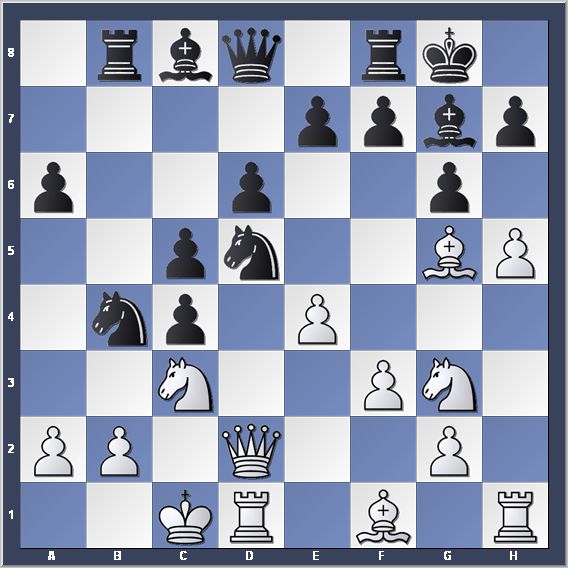
A. 14.Nxd5 Nxd5 15.Qxd5 (15.exd5 Rxb2 16.Qxb2 Bxb2+ 17.Kxb2 Qb6+ 18.Kc2 Bd7 and black should win.) 15...Qa5! threatening 16...Bxb2+, black has a winning attack.
B. 14.exd5 Bxc3 15.bxc3 Qa5! 16.cxb4 Rxb4 17.Qc2 black can win the queen immediately 17...Qa3+ 18.Kd2 Rb2 19.Rc1 Rxc2+ 20.Rxc2 Qb4+ 21.Ke2 (21.Ke3 f6 22.Bh6 Qe1+-+) 21...Qb1 22.Rxc4 Bb7 and black should win; or he can first bring more pieces into the attack 17...Bd7 18.Bxc4 Qa3+ 19.Kd2 Rb2 with a winning advantage.
The knight maneuver 13...Nd7! seems also strong, for example 14.Bxc4 Ne5 15.Qe2 Nxc4 16.Qxc4 a5 17.e5 h6 18.Be3 Ba6 19.Qe4 Qb6 with a massive storm.)
14.Bxc4 Nd7! (I came to this idea one move too late. The knight wants to leap into attack, creating a havoc in white's camp. "As a former King's Indian player you should have known to keep the knight on f6 to defend your king," GM Jan Plachetka told me after the game, but I felt the knight could play a more ambitious role in the game.) 15.hxg6 (At this point Lajos announced "pawn h5 to h6," but it was an obvious slip of the tongue and he quickly corrected himself with "pawn h5 takes g6.")
15...Ne5? (I should have been punished for this reckless move. I was briefly contemplating to retake with the f-pawn, but I thought I could gain a tempo by attacking the bishop. As a matter of fact 15...fxg6 was correct, for example 16.Bh6 Bxh6 17.Qxh6 Rf7 stops white's attack and after 18.a3 Qb6 white can't cash in the knight since after 19.axb4 Qxb4 20.Rd2 Qxc4 black is clearly on top.) 16.Bh6? (Lajos could have finished the game with 16.gxh7+! Kh8 17.Bh6 when black would have had to resort to some acrobatics with 17...Bf6 18.Qe2 Rd8 but after 19.Rd2 making room for the king to move to the kingside, white enjoys sufficient material advantage to win.)
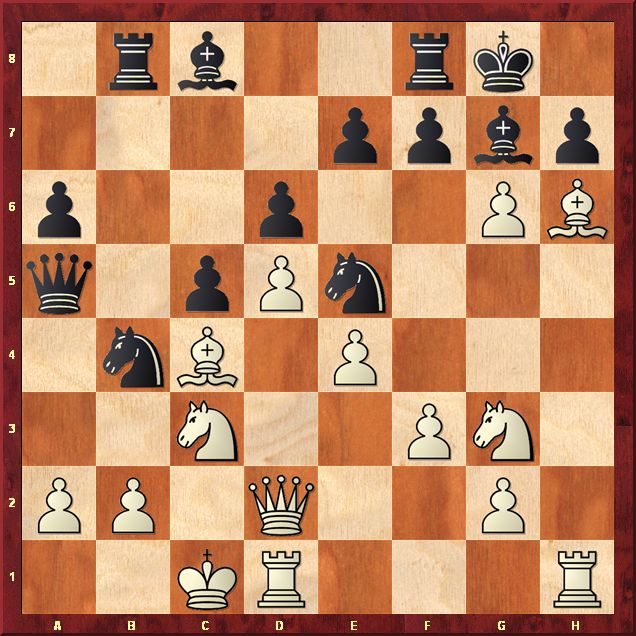
The drums stopped and silence dropped on the old town square. It seemed it lasted an hour, but only a few seconds elapsed. I froze, unable to think. The drums, the applause after each move by nearly 1,000 spectators, brought my brain to halt. Didn't Lajos hang a bishop?
16...Nxc4?? (A terrible blunder. I must have been on another planet, thinking about previous misses and not paying attention to the situation on the board. It was a decisive moment and I failed to fight back with 16...fxg6 17.Bxg7 Kxg7 and white has to be careful, for example
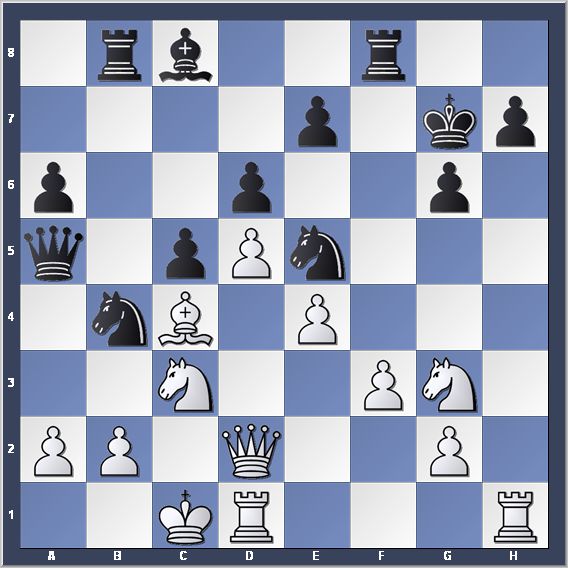
A. 18.Qh6+ Kf7 19.Qxh7+ (19.Nf5! is good here.) 19...Ke8 white went too far, burning bridges behind him. Black has a deadly attack, for example: 20.Bb3 c4 21.Ba4+ Bd7 and black wins.
B. 18.Qe2 Qb6 or18...Bd7 with equal chances ;
C. 18.Nf5+! the best reply 18...Bxf5!? [Other moves are not great, for example 18...Rxf5 19.Qh6+ Kf7 20.exf5 Bxf5 21.Qxh7+ Ke8 22.Qg8+ Kd7 23.Qxb8 Nxc4 24.Rh8 and white wins; or 18...gxf5 19.Qh6+ Kf7 20.Qh5+ Ng6 21.Qxh7+ Ke8 22.Qxg6+ Kd8 23.a3 Qb6 24.Rd2 winning.] 19.exf5 Qb6 [19...h5 is possible] 20.Rde1 Rxf5 21.Qh6+ Kf7 22.Qxh7+ Ke8 23.Na4 Qa5 equalizing.)
17.gxh7+ (This led to a quick mate, but before we got there, lots of pieces disappeared from the live board. The spectators got their money's worth since every capture resulted in a swashbuckling duel on the live board.) 17...Kxh7 18.Bxg7+ Kg8 19.Rh8+ Kxg7 20.Qh6 mate.
"What happened to my king? Did he get killed by a sword?"
"No," they said." They only took his crown away and placed it on Portisch's head."
A new king of Banska Stiavnica was born.
Pictured below from the left: Portisch, the chief organizor Milan Maros, Kavalek.
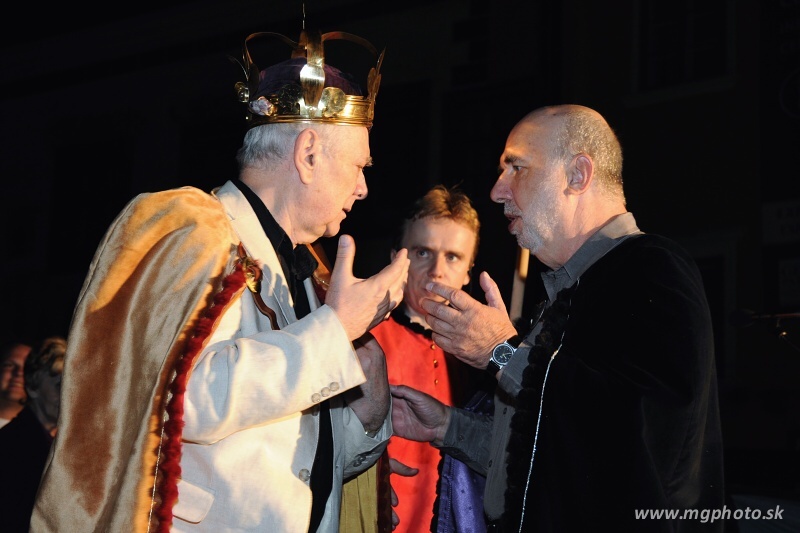
"Congratulations, Lajos. You can smile now!"
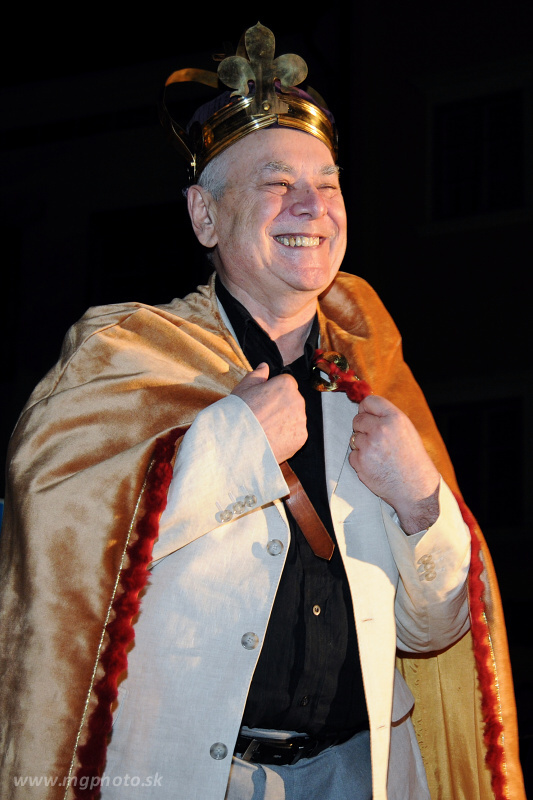
No comments:
Post a Comment